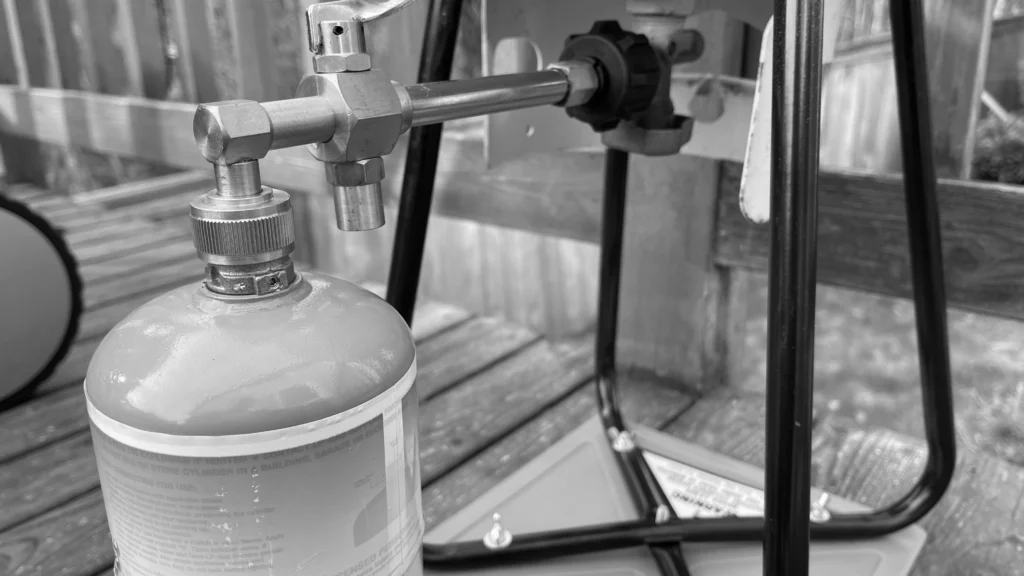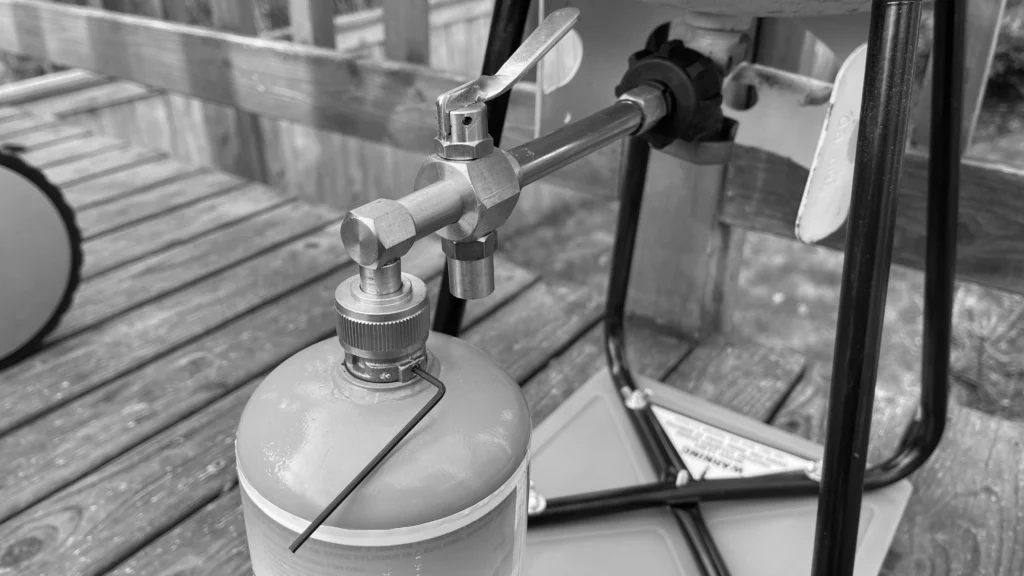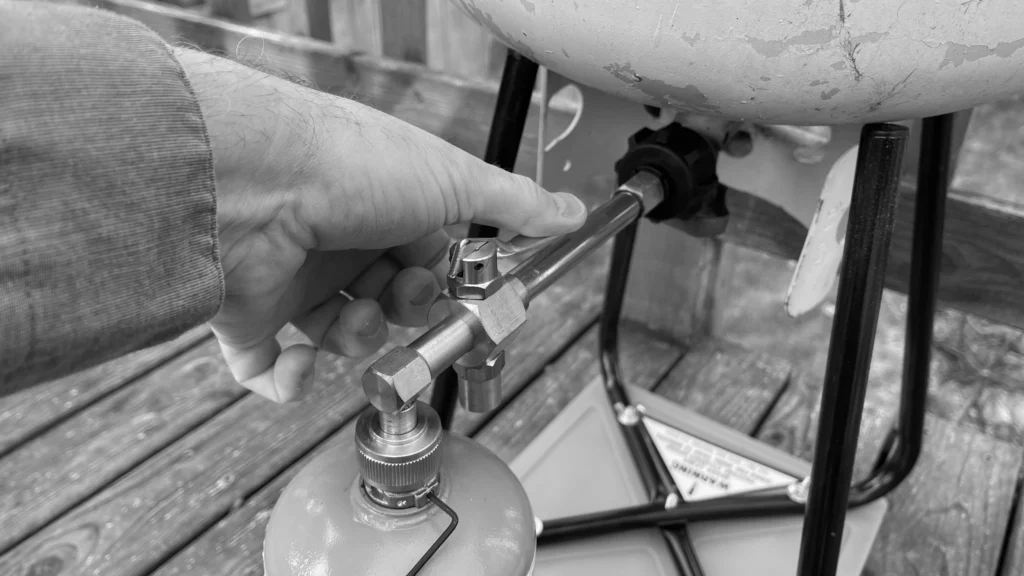
Refilling a Flame King refillable tank YouTube Video
Questions and Risk Management
Are you filling disposable propane tanks? Is this illegal? Have you been doing so for a long time? Why do you refill disposable propane tanks?
Let’s start with what is on your mind. You have been (or thinking of) refilling disposable propane tanks. You may be doing this to save money or reuse equipment to keep the disposable tanks out of a landfill.
You should stop doing this and banish those thoughts from your head and read the rest of this article. This article will refer to disposable non-refillable tanks as DOT 39 cylinders. They are not illegal to fill (dangerous) but illegal to transport if refilled. Check out the USC 49 § 178-65 (LINK). If you are caught transporting a refilled DOT 39 cylinder, you face a $500,000 fine and five years in prison. Transporting a refilled DOT 39 cylinder is a federal crime.
Now that we have explained the legal ramifications, let’s discuss risk management. If you refill DOT 39 cylinders, you have an unnecessary high-risk tolerance. Risk management deals with the likelihood of an event occurring and the ramification of the event’s consequences upon you, your loved ones, and others.
Identify Asset Values
Part of risk management is determining the value of items and people. Start with the highest value: Human life. Follow that with the value of property around you. Determine the value of your freedom, your job, and finally, consider the value of the DOT 39 cylinder that fails.
Identify Risks
To manage risk, you need to identify the potential risks. Let’s assume that catastrophic failure and legal action are potential risks.
Likelihood
At first, the likelihood of a catastrophic failure of a refilled DOT 39 cylinder is low. The first refill increases the likelihood of a catastrophic failure. Over time as the seals, valves, and cylinder walls weaken, the likelihood of a catastrophic failure rises.
At first, the likelihood of being caught transporting a refilled DOT 39 cylinder is low. Over time the likelihood of being caught transporting a refilled DOT 39 cylinder rises the more your transport the cylinder.
Consequences
The consequences of a catastrophic failure of a refilled DOT 39 cylinder are very high. Catastrophic failure may result in the loss of life, property damage, and injury.
The consequence of being caught transporting a refilled DOT 39 cylinder is very high. Being caught transporting a refilled DOT 39 cylinder may result in losing your freedom, huge fines, and troubles related to having a federal crime on your record. Read the book Three Felonies a Day by Harvey Silverglate (sponsored link) if you are interested in what happens when charged with a federal crime.
Overall Risk
Understanding the likelihood and the consequence of refilling a DOT 39 cylinder is easy to calculate. The low likelihood and the very high consequence equate to medium overall risk.
Risk Response
Now that the risk level is identified, you need to determine how you will respond to risk or treatment. There are a few risk response options available to you:
- Accept the risk: This may be where you are right now. You are accepting the outcome and consequences if an event occurs.
- Risk Avoidance: This action is where you stop refilling DOT 39 cylinders.
- Risk Sharing or Transfer: You get someone to refill and transport the DOT 39 cylinder or obtain extra liability insurance and put a lawyer on retainer.
- Risk Mitigation: This action reduces the likelihood of a catastrophic failure or legal action. You can mitigate and reduce risk by using a DOT 4BA-certified refillable cylinder for transport.
Risk Response Costs
Risk response cost analysis is the point where you weigh the risk response costs against the single-loss expectancy and the annual rate of occurrence. One can assume that the single-loss expectancy expense of a catastrophic failure or legal action is high. The annual rate of occurrence of a catastrophic failure and legal action increases with each refill. The overall cost of a catastrophic failure or legal action is lower than the risk response costs.
- Accept the risk: $500,000 or infinite (human life).
- Risk Avoidance: Stop refilling disposable single-use DOT 39 cylinders. Purchase a new one for $6.00 each time you need propane fuel.
- Risk-Sharing or Transfer: The cost of extra insurance and retention of a lawyer to handle legal fees associated with civil and criminal charges. Insurance is nearly impossible to find for illegal acts. Retainer fees are thousands of dollars per month. The legal defence for federal crimes may be hundreds of thousands of dollars. Federal agents are not going to charge you with one crime for transporting a refilled DOT 39 cylinder. It is likely that you will be charged with several federal crimes.
- Risk Mitigation: The one-time cost and long-term upkeep of a refillable DOT 4BA and TC certified for 12 years (10 years in Canada) and UL certified (the valve is tested to the UL1769 standard) cylinder.
Prioritized Risk Response Analysis
Let’s rule out options one (accept the risk (expensive and deadly)) and two (risk-sharing (unethical) or transfer (expensive)).
You are left with options three (risk avoidance) and four (risk mitigation). These options lower the likelihood of a catastrophic failure and legal action. If a failure were to occur, the consequence is still the same. The overall risk is low due to the dramatic lowering of the likelihood of a catastrophic failure and legal action. It is logical to choose these options since the risk response is much lower than the cost of catastrophic failure and legal action.
Single-use of the DOT 39 cylinders removes the legal risk of transport and lowers the risk of seal and metal fatigue failure. The cost of single-use cylinders is moderately low.
A refillable Flame King cylinder has a slightly higher upfront cost, but the return on investment (ROI) is quick. The trade-off of the upfront costs and maintenance coupled with the short ROI is much lower than the catastrophic failure and legal action costs. The refillable Flame King cylinder lowers the likelihood of a catastrophic failure and legal action. This lowered likelihood is the result of thicker cylinder walls, strong welds, and much higher standards for the valves. The refillable cylinder’s transport is not prohibited by USC 49 § 178-65 (LINK). These cylinders are covered by USC 49 § 178.51 (LINK) and are legal to transport after refilling.

Recommendations
Use a refillable propane cylinder. The upfront cost and maintenance are low, and your ROI is met on your sixth refill. The product that meets this recommendation is the Flame King Refillable Propane Cylinder and Refill Kit (sponsored link).

